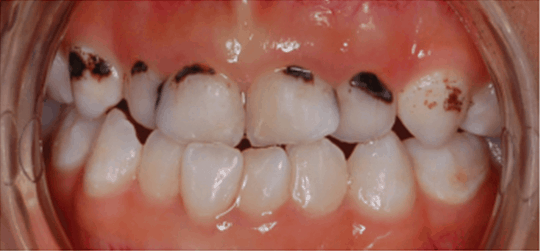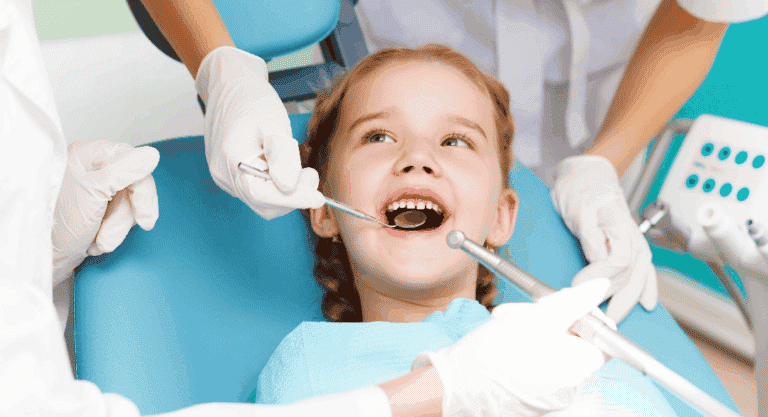What are Early Childhood Caries?
When 1 or more decayed, missing or filled tooth surfaces are present in primary teeth/milk teeth in a child up till age of 71 months is characterized as Early Childhood caries.
What causes Early Childhood Caries?
- Diet: It is commonly caused by bottle feeding of sweetened milk or juice or frequent snacking of sugary food items. The child suffering from Nursing bottle caries is usually observed to suck on sweetened milk bottles or sweetened pacifiers during or before sleep.
- Microbial: The primary cariogenic bacteria that causes Early Childhood Caries are Streptococcus Mutans and Lactobacillus, which is passed from primary caregiver to child. The oral cavity is not colonized with bacterias until primary teeth/milk teeth erupt. Food debris and bacteria together form a biofilm on the surface of tooth called Plaque. In Plaque, these cariogenic bacterias ferment carbohydrates (like lactose, glucose and sucrose obtained from milk bottles) to produce lactic acid. This acid attack causes demineralization of enamel and thus result in caries.
What are their stages?
- Initial Reversible Stage: It begins as asymptomatic, chalky, opaque and demineralized carious lesion that predominantly cervical and interproximal areas. It is characterized by no pain.
- Damaged Carious Stage: Upper front teeth i.e. Maxillary Anteriors are affected. Carious lesion here involves dentin and shows yellowish-brown discoloration.
- Deep lesion: Depending on the frequency of use of sweetener and its cariogenicity, molars (back teeth) also get involved. Pain may be experienced in this stage and maxillary incisors my also show pulpal involvement.
- Traumatic Stage: Teeth become weak by the time this stage advances. Molars display pulpal involvement and maxillary incisors may become non vital.
What are the implications of ECC?
- The child with ECC is more prone to develop them in permanent dentition as well.
- Early Childhood Caries can affect the speech, aesthetics and mastication of the child.
- Failure of adequate space maintenance can result in malocclusion in permanent dentition.
- Development of aberrant oral habits

How can you prevent and treat Early Childhood Caries?
A low-sugar and High nutritional diet are recommended for the mother as well as the child, especially during breastfeeding. Optimum oral hygiene should be maintained by brushing the child’s teeth twice daily with soft-bristled and size-appropriate toothbrushes.
However, children under the age of two do not require toothpaste. Chemotherapeutic mediators, such as povidone-iodine and chlorhexidine, are known to possess antimicrobial effects. Chlorhexidine varnish can serve as a protectant for teeth surface. Fluorides are also effective in preventing caries.
Therefore, the usage of fluoride toothpaste, fluoride mouth rinse, and professional topical fluoride application should be incorporated. Application of casein phosphor peptide (CPP) based compounds could stabilize the calcium and phosphate in the tooth substance, thereby maintaining them in an amorphous insoluble form i.e. known as amorphous calcium phosphate (ACP) form.
Thus, they can prevent tooth demineralization and promote re-mineralization and fluoride action. Children at moderate risk of ECC should receive restoration of all the carious lesions, while white spot and incipient caries should be treated by preventive measures and checked for progression.
However, children at higher risk may require earlier intervention. Stainless Steel Crowns can also be used to restore molars.
Expert’s Opinions
- Dr. Zita Antao Dental Director of Sabka dentist says “Rampant caries is a suddenly appearing and rapidly burrowing type of caries that involves pulp earlier such that more than 10 new lesions appear every year on healthy teeth surfaces which are generally immune to caries.”
- Dr. Jena Shah Dental Director of Sabka dentist says “An indication of Early Childhood Caries would be involvement of tooth surfaces that are usually at low risk for caries, such as the labial surfaces of maxillary incisors and lingual and buccal surfaces of maxillary and mandibular molars.”
- Dr. Preethi Nagarajan Dental Director of Sabka dentist says “Early Childhood Caries is commonly caused by night time bottle feeding, frequent snacking and a high sugary diet.”
References
Early Childhood Caries – NCBI
Early Childhood Caries – Wikipedia
Early Childhood Caries – International Journal Of Dentistry





